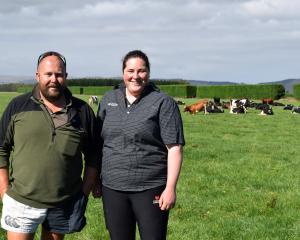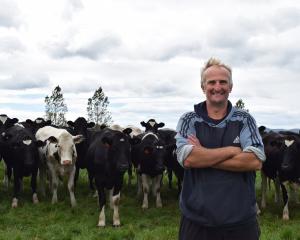
University of California, Davis’ Prof Frank Mitloehner told an audience at Lincoln University that financial incentives by the Government were helping them get to a climate-neutral position.
Managing methane could make a meaningful contribution to climate scenarios and financial incentives to do this were essential, he said.
The air quality specialist in the department of animal science broke down the science in his talk ‘‘How Managing Methane from Livestock can be a Climate Solution’’ to explain methane’s impact on climate change and work by the dairy industry to reduce emissions.
‘‘I believe agriculture can be part of a climate solution, particularly when managing methane. Methane is the Achilles heel on the one side, but is also a real opportunity on another side.’’
Prof Mitloehner said New Zealand had been an ‘‘eye-opener’’ for him in his first visit to the country.
New Zealand was among the most active policy arenas in the world in the greenhouse gas sphere — like California — but its extensive, pasture-based system was different.
‘‘I’m not here to tell you how to do it right.
‘‘In fact, you will say ‘the way they do agriculture in California is significantly different from the way we do it’ which is very true as we are very intensive, very large scale and you are extensive and many of the farms I see here are farms that would not be viable in California. A farm with fewer than 500 cows is not financially viable in California.
‘‘Nonetheless, I think you will find some lessons can be learned from each other because we are in a similar situation with some of our policies.’’
California is a leader in environment and climate change in the US as its largest agriculture producer of 400 specialty crops, fruit and 20% of the nation’s dairy. Dairy is the top revenue earner and operators typically house milking cows in free style barns with no walls. Over the past few years trees, solar power parks, different silage storage and anaerobic digesters called carbon lagoons have been added.
Digester numbers have risen from about 10 in the state five years ago to 220 now.
The covered dairy lagoons trap biogas from manure, of which 60% is methane. After being cleaned up, the biogas is converted to renewable natural gas which has become a heavy transport fuel for trucks and buses.
The gas is considered by the California’s Air Resources Board as the most carbon-negative fuel type there is.
For reducing dairy emissions and producing the clean fuel, dairy farmers receive low carbon fuel standard credits. The average cow produces $US4000 ($NZ6490) in milk per year and about six months ago the credits were providing US$2000 per cow.
‘‘These credits have come down since but they are still high and guaranteed for 10 years. That approach has really led to farmers to run to this technology,’’ Prof Mitloehner said.
The rapid increase of digesters could be expected to continue for the state’s 1.8million cows and the resulting biogas could be used for heavy duty industries and hybrid vehicle fleet, he said.
Policy-makers globally wanted to know how they could most effectively help farmers to reduce emissions and achieve climate goals, he said.
‘‘There are different approaches throughout the world and I would put them into two general bids. I call one the ‘cane approach’ and the other the ‘carrot approach’.
‘‘The cane approach is one in general terms where you use rules and regulations, fines, maybe taxes and you tell farmers you need to reduce ... [so much] of pollutant X by this time and if you don’t do it you will be fined, taxed or something else will happen to you.’’
One of the worst examples of this was in the Netherlands which had decided to only make agriculture the target for nitrogen reductions and had put €25billion ($NZ42.9billion) on the table to reduce livestock numbers by buying farms in return for farmers stopping farming. This had resulted in mass protests by upset farmers, a disconnect between farmers and policy makers and another nation would end up putting in more cows because of demand, he said.

Other parts of the world such as California were using the carrot approach.
‘‘In the US we see a different approach and this approach is where so-called climate-smart communities receive a lot of funding with $US2.8billion of Federal dollars with $US800million going to a beef and dairy sustainability. The government of the US is actively supporting farmers to reduce emissions.’’
The California Dairy Research Foundation was also awarded $US85million as a financial incentive for dairy producers to adopt smart manure ways to reduce emissions.
California is the only state in the US to have a methane law which insists on a 40% reduction of methane by agriculture and other sectors by 2030.
Prof Mitloehner said new analysis by the university showed California projects in place today, coupled with a moderate feed additive strategy, were on track to reduce between 7.6 to nearly 10.6million tonnes of methane (CO2e) by 2030, from the dairy sector.
California dairies had already reduced 2.3million tonnes and achieved 30% of the sector’s methane reduction emission goal, as well as making money doing that, he said.
Methane was a potent, but fast-burning greenhouse gas that once reduced by 20-30% would become climate neutral without further warming, he said.
The notion of methane being a super pollutant stemmed from a matrix called GWP100, which was developed in about 1990 around the Kyoto Climate Accord and compared methane with carbon dioxide (CO2) emission equivalents to work out the warming potential, he said.
Methane might be more potent than CO2, but it was not a CO2 on steroids because it behaved differently in the atmosphere and warmed the planet differently, he said.
Methane is produced and destroyed and its ‘‘fast and furious’’ lifespan is much shorter — about 12 years — compared with centuries for CO2.
‘‘A constant livestock herd produces a constant amount of methane, but almost an equal amount of methane that’s produced by a constant herd is also naturally destroyed and that means when you have a slight reduction of methane per year and that reduction is 0.3% ... then you are not causing additional warming.’’
GWP100 over-estimated methane’s warming impact of herds by a factor of three to four and this was recognised last year by an Intergovernmental Panel on Climate Change report that confirmed that simply expressing methane emissions as CO2 equivalents overstated its effect, he said.
Whereas the GWP Star matrix accounted for the atmosphere removal and the short-lifespan of the greenhouse gas.
‘‘Why I don’t hear [of] people, particularly farmers, know[ing] this is beyond me. It seems like the world has not really read that. Think about what this means — [GWP100] is the matrix that has been used for the last 30 years. When applied to agriculture and constant sources from agriculture it means that we are really blowing the impact of this gas out of the water and that is the reason why I’m advocating we use GWP Star, not because it makes farming look better but because it’s more scientifically accurate.’’
GWP Star characterises the impact of the rate of change of methane over time and was not a ‘‘get out of jail free card’’ for agriculture, he said.
Prof Mitloehner said lazy and false reports wrongly portraying him as downplaying methane, a farmers’ friend advocate for GWP Star and him calling for the end of GWP100 were all ‘‘urban myths’’.
He said it was wrong to assume that academics working in agriculture had a conflict of interest as they were trying to improve the sustainability of the sector.
‘‘Some people don’t understand that. To me its disheartening to see that there are people who say ‘this guy cannot be trusted as he works with agriculture’ It’s as if I were to work with the mafia. The people who grow our food deserve to be treated as well as with our health [people].’’
TIM.CRONSHAW @alliedpress.co.nz














